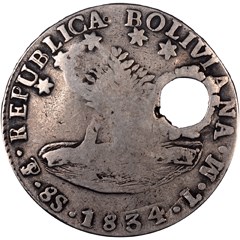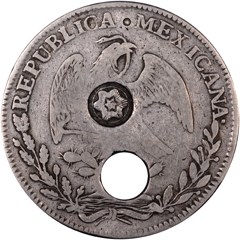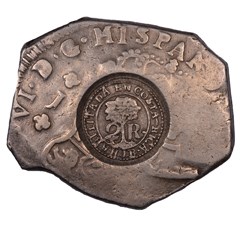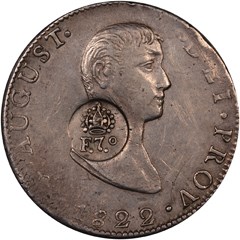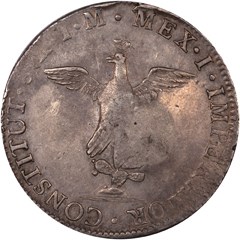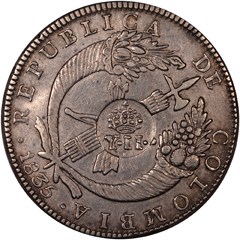Interesting Counterstamped World Coins
Posted on 10/13/2015
Coins that are counterstamped have been struck with a separate set of (usually smaller) dies that feature a different design. There are many reasons why coins are counterstamped, but one of the more interesting cases is when a government counterstamps foreign coins to indicate their legal tender status and denomination in its own country. This practice was used when a government was unable to strike coins of its own and foreign coins were substituted instead. Sometimes, foreign coins were of a higher weight than the desired denomination and so the weight had to be reduced.
For example, in the early 19th Century, Costa Rica took American half dollars and reduced their weight by removing a circular piece of metal from the center and then counterstruck them with a star as you can see below. These were then circulated in Costa Rica as 4 Reales.
Costa Rica also used Bolivian and Mexican coins in the same manner. The two examples below were struck on an 1834 Bolivia 8 Reales and an 1828 Mexico 8 Reales.
Below is a neat example of another Costa Rican counterstruck coin. The host coin is a 1752 Guatemala 8 Reales that has been counterstruck with Costa Rican 2 Reales dies. To the left on the obverse a small 8 to signify that the coin is not actually a 2 Reales, but an 8 Reales instead.
The situation was slightly different in the Philippines in the 1820s, however. For over 250 years, the Manila-Acapulco galleon trade had brought in Spanish American coinage for circulation in the Philippines. After the trade’s discontinuance in 1820, private companies brought in the coins instead. When those Spanish American countries, including Mexico, Peru, Columbia, Bolivia, and Chile, declared their independence from Spain in 1823, their coinage began to carry mottos which exemplified the rebels’ libertarian ideals.
The Philippines were still under the rule of Spain, and they were unsure of the legality of allowing coins with anti-Spanish legends to circulate in the colony. Fearing the collapse of the economy without circulating coinage, the colonial government allowed the coins to circulate as a temporary measure. In 1828 it was decided that the solution to this problem was to counterstrike the rebel coins. This would not only prove that the coins were of the correct weight and fineness, but would also have the added benefit of eliminating all or part of the rebel mottos on the coins. Here is an example of a Philippines counterstruck 8 Reales. The host coin is an 1827 Peruvian piece struck in Lima of the same denomination.
The coins that the Philippines counterstruck were annealed, or heated, before striking. This allowed for the next step, which involved hammering the coins to remove detail before striking. Sometimes that process didn’t remove enough detail, however. Here is another example of an 1828 Philippines 8 Reales struck (rather poorly in this case) over an 1827 Peruvian 8 Reales.
Unfortunately, a large crack was discovered across the shoulder of the counterstrike press on March 28, 1832. This made the press essentially useless, and therefore a new method of counterstriking coins was necessary. Due to the damage done to the press with the large countermarks, it was decided that smaller hammer punches would be used. Below is an example of one of these issues. The counterstamp consists of a Crown with F.7.° below, which stands for Ferdinand VII, the King of Spain. This particular coin is struck over an 1822 Mexico 8 Reales and is from around 1834.
The last type of Philippines overstruck coinage to be discussed here was very similar to the last. It too used a small, hammered punch. This one was used after the death of Ferdinand VII on December 20, 1834. The crown remained, but the initials Y: II for Queen Isabella II, his daughter and successor, were used. An example of this type can be seen below. This one has been struck over a Colombian 8 Reales and was struck circa 1837.
Coins were counterstamped by many different countries, as well as countless private individuals, in addition to the Costa Rican and the Filipino pieces discussed above. When blank planchets or fully-sized coining dies were unavailable, it was much easier to simply strike a number, symbol or simplified die into an already-struck coin and declare it legal tender. Due to the vast numbers of interesting counterstruck coins that exist today, it is impossible to cover even a tiny portion in one article. Therefore, keep a look out for further articles on interesting counterstruck coinage in the future!
Sources:
- Basso, Aldo P. (1975). Coins, Medals and Tokens of the Philippines 1728-1974, Second Edition. Quezon City: Bookman Printing House.
- Oropilla y Fortich, Quintin. (2001). Philippine Counterstamped Coins, 1828-1839: With Original Archival Documents: History and Mintage. Quezon City: Noumisma-Economic History Research Pub.
Stay Informed
Want news like this delivered to your inbox once a month? Subscribe to the free NGC eNewsletter today!



